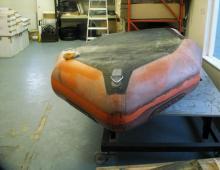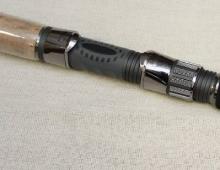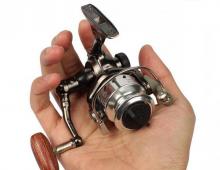Feeder equipment: do-it-yourself manufacturing and installation
Asymmetrical loop
Feeder equipment is the basis of the bottom rod, thanks to which every touch of the fish to the bait becomes visible to the angler. A properly equipped feeder allows you to feed the fish at a promising fishing point, determine the type or size of the fish by biting, tip the scales in your favor during the fight.
Complete set of feeder equipment
The main components in various feeder rigs are:
- main line
- swivel
- carbine
- crimp tube
- feeder or sinker
- limit stop
- anti-twist tube
Some anglers mount the rig directly on the main line, making knots, limiting the movement of the feeder with a stopper. Other feeder lovers make ready-made elements at home, using different thicknesses of fishing line and making several types of rigs. Crimp tubes can be used instead of knots.
Types of feeder equipment
Anglers use several basic types of feeder equipment.
- Paternoster. The most versatile rig that is used in feeder fishing is the paternoster. The Gardner loop, as the paternoster is also called, is easy to install. In terms of sensitivity, it is somewhat inferior to the asymmetric loop.
- Asymmetrical loop. It is distinguished by high sensitivity, and in strong currents it reduces the twisting of the equipment and the leash.
- Symmetric loop. It is applied on a weak current and in reservoirs with stagnant water.
- Helicopter. The rig is a modernized paternoster. The feeder is mounted at the end of the main line, and the leash slides along it. Works well on the course with a weak bite.
- Equipment with anti-twist. The feeder is attached directly to the tube through which the main fishing line is passed. Additional elements can sometimes scare cautious fish.
- Combine. This rig is a symbiosis of an anti-twist and a paternoster. To the tube, the feeder is mounted through a piece of fishing line. When hooked, only the feeder comes off, and the rest of the equipment is preserved.
- Inline. In this rig, the feeder glides along the main line thanks to a swivel and carabiner. Its movement is limited by a stopper. A leash is tied to the end of the main line.
Feeder fishing is the largest guide on the site about feeder fishing (baiting and angling techniques).
Do-it-yourself feeder - a complete guide to assembling feeder gear and the correct fishing technique.
What to catch bream on - all about bait and bait for bream using the feeder method of fishing,.
Paternoster (Gardner rig)
Paternoster Gardner - the simplest feeder equipment for fishing on muddy ground

Loop Gardner considered the simplest feeder equipment. In skillful hands, you can make a paternoster in a minute. The simplest equipment is made on the main fishing line using knots. Before tightening the knots, it is necessary to moisten the fishing line.
First, a small loop is made at the end of the braid or monofilament. A leash with a hook and bait will be attached to it. From this loop you need to measure 10-15 cm and tie the second loop. It can be small or large, depending on how the angler prefers to mount the feeder. When the feeder is attached in a loop-to-loop manner, a large element is required. If the installation is carried out through a swivel and carabiner, then the loop may be small.
Now it remains to attach the feeder and leash and the tackle is ready to go.
Asymmetrical and symmetrical loop
Symmetric loop

The loop system is made separately, and is attached to the main line through a swivel with a latch. For knitting an asymmetric (asymmetrical) loop, a piece of fishing line is taken from 1 to 1.5 m long with a diameter of 0.2-0.4 mm. It is important that the fishing line is rigid, for example, made of fluorocarbon.
The prepared piece of fishing line is folded in half, while one side is made 10 cm longer than the other. Using a double or triple knot, a loop is made for mounting the leash. It is more difficult to make a lead-off leash, which should be hard and dense. Then the number of overlaps with a leash will be less.
From a double fishing line, a twist is made from 10 to 15 cm long, which ends with a double knot. A swivel is threaded onto a long piece of fishing line. Now the desired length of the asymmetric loop is measured and the double knot is tightened. Usually the long side is made from 40 to 70 cm, and the short side is 30-60 cm.
In a rig with a symmetrical loop, both sides are the same. At the end of the loop, a knot is knitted with a swivel for attachment to the main fishing line. The ends of the fishing line are carefully trimmed.
Helicopter
Mounting the helicopter is quick and easy. A stopper is put on the fishing line, a swivel with a carabiner for a leash, a cambric. A swivel with a fastener for the feeder is tied to the end of the fishing line. The cambric is tightly put on the loop of the swivel. The distance between the leash swivel and the feeder usually does not exceed 20 cm, most often anglers make a length of 5 cm. It is important that the stoppers sit tightly on the line and do not move spontaneously.
Equipment "Helicopter"

Tool with anti-twist
One of the simplest feeder rigs is the use of a curved anti-twist tube. The longer part of the tube should be facing the leash, so that when casting the equipment, take it away from the feeder. The anti-twist is put on the main line, a bead damper is installed to stop it and a swivel is tied. A leash is mounted to the swivel.
Equipment for feeder with anti-twist

harvester
The feeder equipment "Combine" uses an anti-twist, and the feeder is attached with a loop

Equipment of this type is based on an anti-twist tube. Only a fishing line is tied to the swivel (which is on a tube) in the form of a large loop up to 10 cm long. And a feeder feeder is mounted to it. Usually such snaps are made at home on different anti-twist, with short and long loops. The main fishing line is pulled through the tube and is stopped by a small cambric.
Inline (in-line)
In this type of equipment, the feeder must be on the main line in a moving or stationary state. A swivel with a clasp, a stopper clings to the main fishing line, and a loop is knitted at the end for attaching a leash. The feeder is mounted to the fishing line with a carabiner. Sometimes a fixed attachment of the feeder is made by installing another stopper above the swivel.
Equipment "Inline"

A popular feeder in carp fishing called the "method" is also mounted on an inline-type rig. The main fishing line is passed through it, a silicone stopper is installed and a loop is made for the leash. Filling the feeder with bait, the bait with the leash hook is pressed from above.



